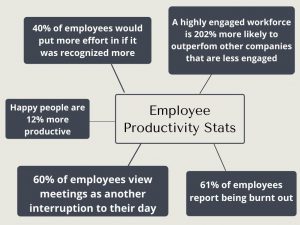There’s nothing more frustrating than being down a few team members, right? When employees are absent, it seems like you just can’t get as much done, and you’re left scrambling to fill the void. But is absenteeism really the worst thing for your business’ productivity and bottom line? Turns out, it might not be. In fact, the problem of “presenteeism,” or being at work but not being really all there, might be a much bigger problem. So what is presenteeism, and is there a way to combat it and get your employees and your business back on track?
What Is Presenteeism?
Let’s start by taking a look at what we mean when we use the words “absent,” “absenteeism,” and “presenteeism.”
- Absent: This simply means that an employee hasn’t come to work for an important reason, like illness, family issues, vacation, or jury duty. There shouldn’t be any problem with taking days off if needed; this time is extremely necessary for employee productivity.
- Absenteeism – Taking days off is one thing, but it becomes absenteeism if it is habitual. If this is happening, you’ll need to look at the cause and try to address it: something like burnout, harassment, mental health issues, or a difficult situation at home could be causing the problem. In general, 1.5% is a very good rate for absenteeism; a higher rate can indicate an issue.
- Presenteeism – Some employees will take time off when needed, and others won’t, which can lead to presenteeism, or situations when employees come to work but are unproductive on the job or not working at their full capacity. This can be caused by many things, including:
- Illness/mental illness/chronic diseases (this is generally agreed upon to be the most common, and so most problematic, cause of presenteeism)
- Burnout
- Harassment
- Demotivation
- Problems within a team/conflicts
- Time management issues
- Stress
Coming to work and “powering through” under these conditions doesn’t do anyone any favors: your employee will suffer, and so will your business. But what price is your business paying for this phenomenon?
How Big of a Problem Is Presenteeism?
Now that we’ve laid out what presenteeism actually means, let’s look at its devastating effect on productivity, and your bottom line. Consider this:
- According to a GCC Insights report by Global Corporate Challenge (GCC) from 2016, while employees were absent from work an average of 4 days per year each, they confessed to being unproductive on the job for 57.5 days each, or almost 3 working months.
- Absent workers cost employers around $150 billion per year, but those who come to work but are not fully present around $1,500 billion per year in the US, based on Bureau of Labor (BLS) data
- The Journal of the American Medical Association has reported that depression sets U.S. employers back some $35 billion a year in reduced performance at work, and that pain conditions such as arthritis, headaches, and back problems cost nearly $47 billion. Not only that, but the researchers also found that the on-the-job productivity loss resulting from depression and pain was roughly three times greater than the absence-related productivity loss attributed to these conditions.
- When it comes to healthcare costs for employees, studies have shown that only around 30% is attributed to direct medical care and pharmaceutical costs, usually in the form of premiums an employer pays to an insurer. Another 9% is associated with short- and long-term disability and worker’s compensation. Just 6% is the result of absenteeism. The overwhelming majority of the cost – a whopping 60% – is attributed to health-related lost productivity caused by presenteeism. That means presenteeism costs employers two to three times more than direct medical care.
- According to one study, 69% of respondents reported going to work while sick at least once in the past year. Workers who did go to work while sick estimated that their productivity was reduced by 23%.
These numbers should worry you, and should make you wonder what exactly is going on. Why are employees at work, but not all there?
What’s Happening?
So what’s going on here? Being absent is clearly not a problem in our workplaces. After all, according to the BLS, the 2018 US annual average absence rate is 2.9%, and some studies show that the median worker takes only one absence day per year, while workers in the 90th percentile take 7 absences per year. But this might be part of the problem: workers are not taking enough time off. Why are they showing up, and not working to their potential? It could be down to multiple reasons, including:
- Little to no paid sick days being offered to them
- Job insecurity
- Understaffing
- Unrealistic expectations from their employer
- Time pressure
- Harassment for taking a sick leave
- Huge workload
Take a good look at the issues above, and consider if your employees might be feeling pressure to come to work, even if they’re not at their best, or if they’re forgoing things that are necessary to their mental health and work/life balance, like taking vacations. As we think about that, let’s now take a look at what can be done to help combat presenteeism.
What Can You Do?
Presenteeism can obviously be harder to spot than absenteeism: you know when someone doesn’t show up for work, but you often can’t tell when or how much something going on under the surface, like mental or physical illness or stress, is hindering someone’s performance. But there are things you can do to try to combat presenteeism, and both make life better for your employees and do a favor for your business’ finances.
Recognize the problem
Now you know that presenteeism could be a problem in your workplace, so it’s time to be on the lookout for it. While it can be hard to spot, as we pointed out, it doesn’t have to be. According to Dr. David Batman, GCC’s chief medical officer, and a registered consultant specialist in occupational health with expertise in psychological health at work, employers need to be more tuned into the well-being of their employees:
“I preach a simple message – pay attention if you notice something has changed. Employees at all levels of a business may be stressed, distracted, and struggling to perform at work. As a result, they may be fatigued and this can affect their concentration. So if employees’ engagement with their job decreases or they seem unconcerned about outcomes, you may have a problem – and you will need to act.”
Be clear that it’s ok to take time off
We need to change the conversation, and start prioritizing both under-performance issues and employee wel-lbeing over absenteeism. In the past, it was believed that productivity was connected to attendance, and still today, visibility is related to productivity and efficiency, so employees feel like they need to prove themselves just by being there.
But as Dr. Batman points out, “We need to stop talking about how many sick days people are taking and focus our energy on what they’re doing when they’re actually at work.” And that means giving them the time they need to recover, and doing the following:
- Don’t have a disciplinary policy related to absenteeism. This will only encourage employees to work when they’re not up to it.
- Set a good example, and take time off when you need it.
- If you notice someone is unwell, or if they are not themselves, send them home or even let them work from home for a while if that’s best.
- Do your absolute best to offer adequate paid time off and/or sick leave.
- Consider offering a workplace wellness program.
- Make sure you have enough staff to cover an employee if they can’t be at work, otherwise they might feel pressured to always be there.
- Reduce the stigma around mental health issues in your workplace, and make clear that you prioritize their mental well-being by offering them time off and coverage for mental health treatments.
Presenteeism is not about workers pretending to be sick to get out of work, or fooling around on the job and not getting things done, it’s a problem in our culture that values attendance over wellbeing. Hey, no one likes working when they’re sick, stressed, or overwhelmed, right? And the numbers prove that not only do people not like it, but it’s bad for their productivity, and for your bottom line. So it’s time to focus on creating a workplace that’s healthy for employees’ bodies and minds, so you can achieve your goals and keep your employees happy and motivated.








